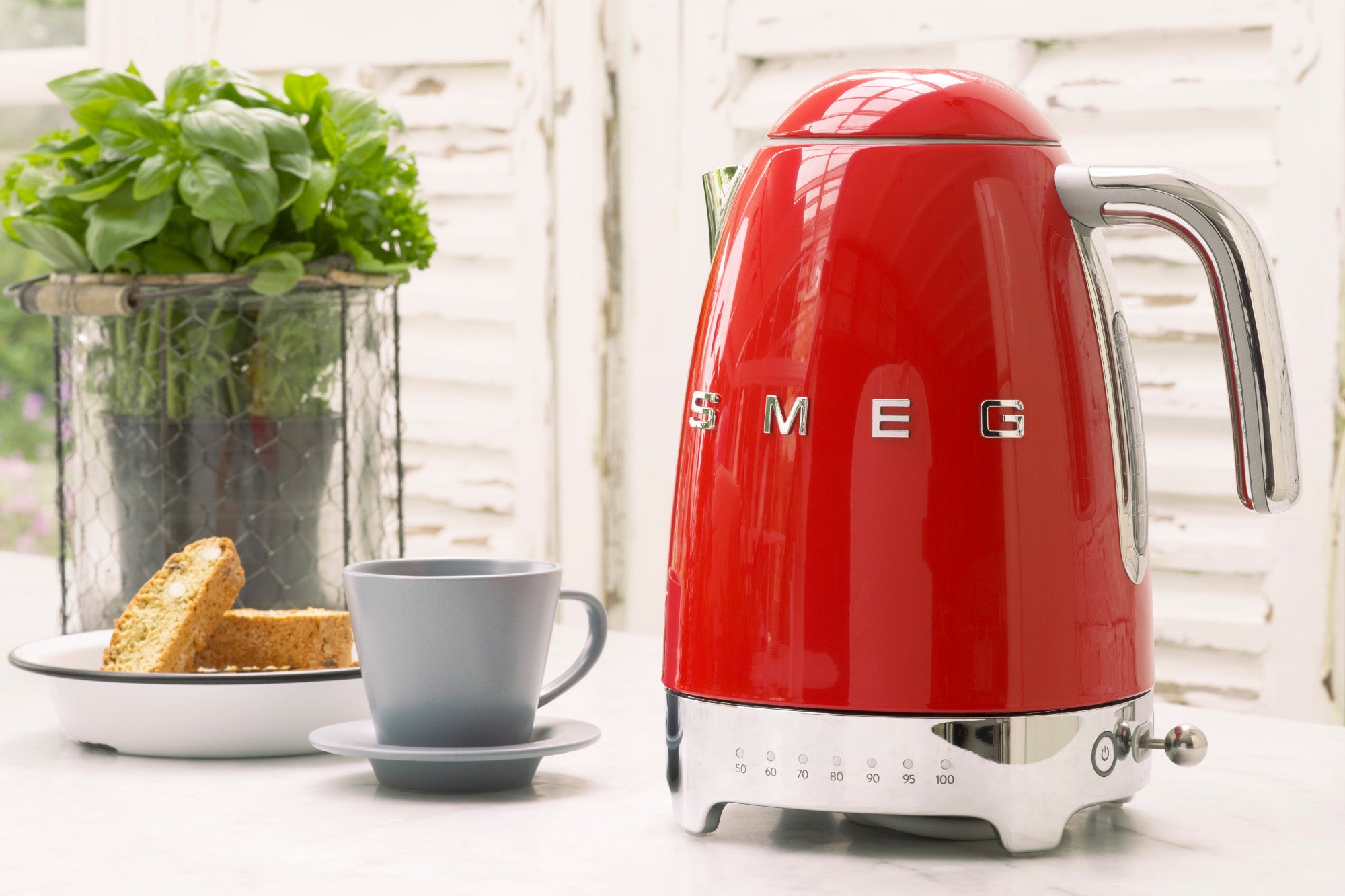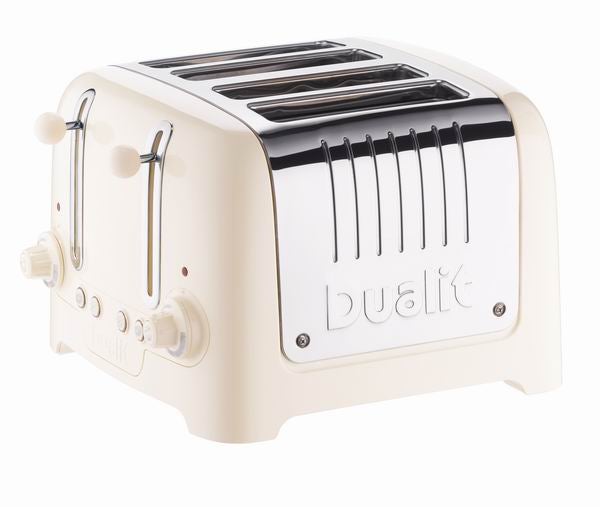The Salter Elder Two-Slice Toaster is a good looking two-slot device at a low price. It’s not bad for features, either, but shallow slots and an unreadable browning dial take the shine off. It’s hard to love its fake wood toasting lever, either.
Pros
- Looks great
- Reheat and defrost functions
- Affordable
Cons
- Shallow slots
- Poor browning control
- No single-slice setting
Availability
- UKRRP: £35
- USAunavailable
- Europeunavailable
- Canadaunavailable
- Australiaunavailable
Introduction
This two-slot toaster is part of the Salter Elder range, which is mostly distinguished by muted, modern panel colours and a dash of wood. This is a budget toaster, but it doesn’t look like it – its teal panels look fantastic in a modern kitchen. It’s a shame, then, that its browning control is awful, and its slots are just a bit too small.
Design and features
- Looks great
- Basic features
- Awful browning control
This isn’t quite an entry-level toaster, but it’s still a cheap device. Many toasters at this price are plastic clad and cheap looking, but the Salter Elder two-slice is an exception. Made from metal, with lovely deep teal side panels, it looks much better in the flesh than in photos, complementing my dark grey kitchen countertop nicely.
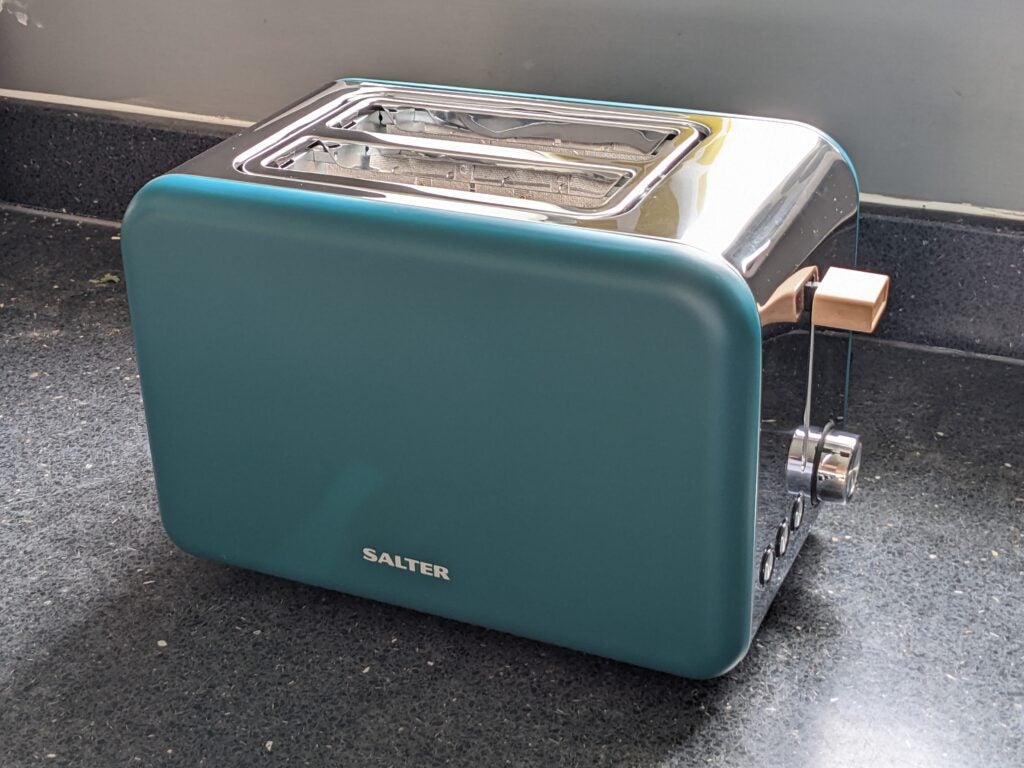
It’s not all great, though. While Salter’s description suggests you get a touch of wood, the toasting knob is actually plastic. In the flesh, it’s none too convincing: a slightly cheap note on an otherwise good-looking product. On the plus side, this is a small and light toaster – ideal if you hope to tidy it away when not in use. It’s also helpful when you need to empty the crumb tray.
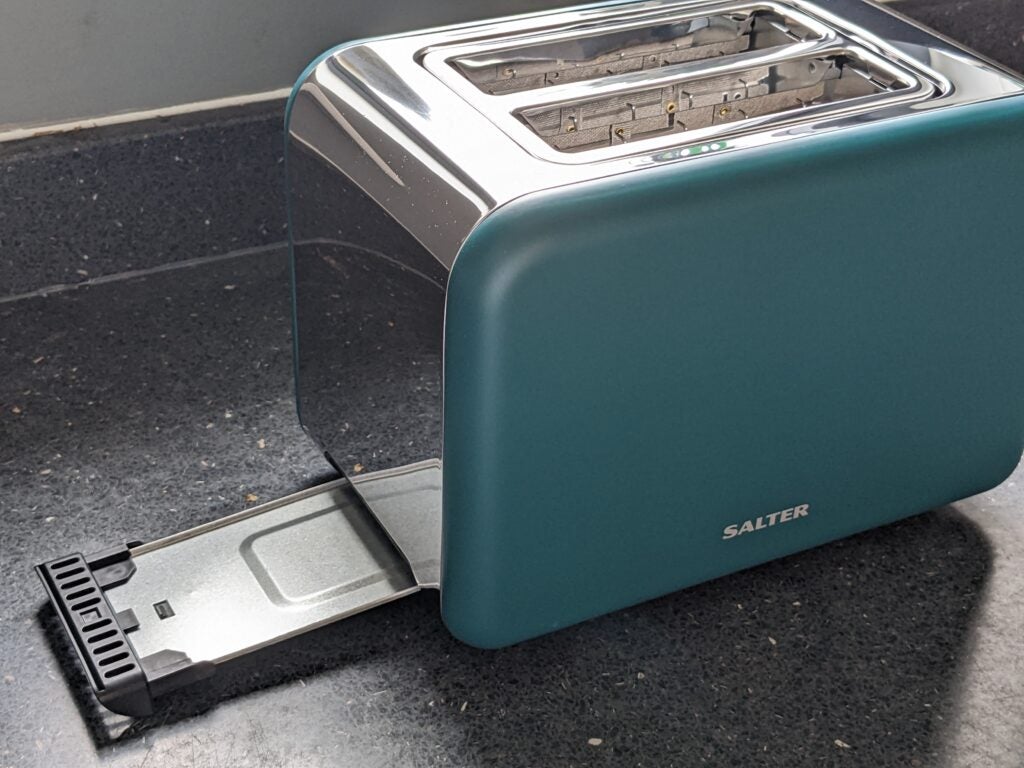
This toaster has two parallel slots, with conventional wire-type elements. It features useful frozen and reheat modes, but there’s no baguette/bagel mode. It’s also missing a single-slot button – if you only fancy a slice, you’ll still be paying to heat both slots. As you’d probably expect, the toast basket isn’t damped, and there’s no bell to alert you when it’s done. Unless you’re in the kitchen, you might miss the relatively muted noise it makes when popping up.
This toaster’s chrome browning control looks great, until you try to use it. There are six toasting levels marked around the outside, but only a tiny dimple on the rotating ring to show you which one you’ve selected. You’ll need keen eyes and decent light to even see this from straight on, and it’s literally invisible from the top of the control. It desperately needs a bold black line across the outside and front of the ring.
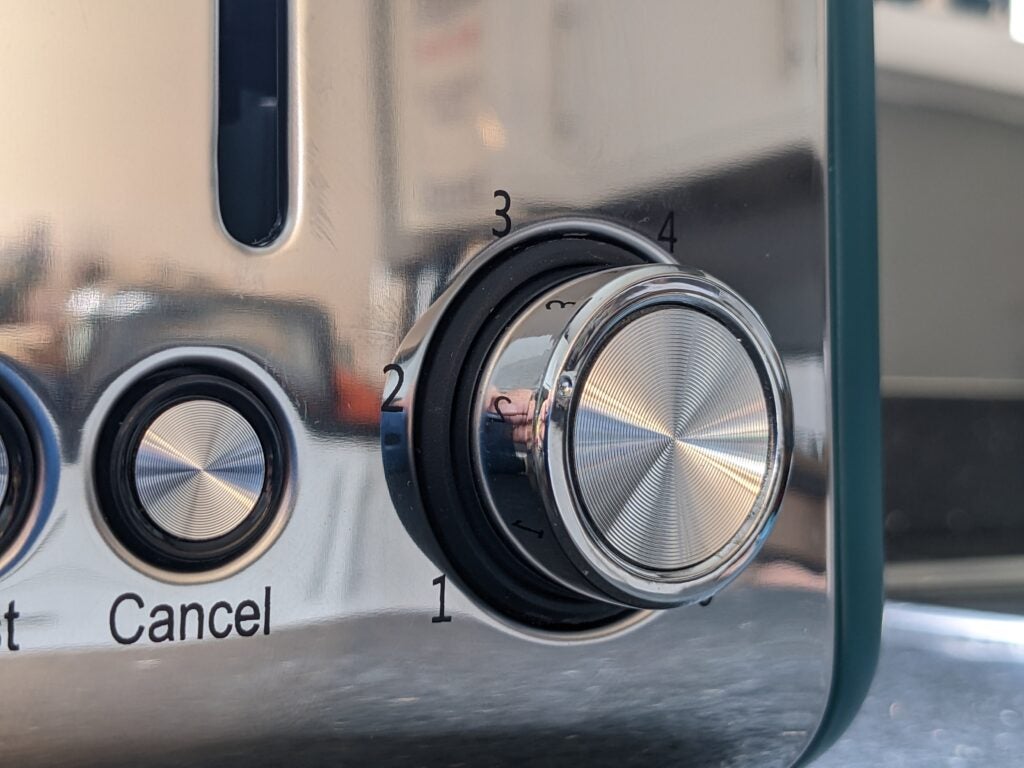
In use, another limitation quickly becomes apparent. This toaster’s slots can accommodate a cut bagel, and they just about handled thick-cut homemade bread, but they’re too shallow. Even supermarket sliced bread was slightly too tall for them. I toasted it lying down, and even then the slots were only just long enough to fit it in.
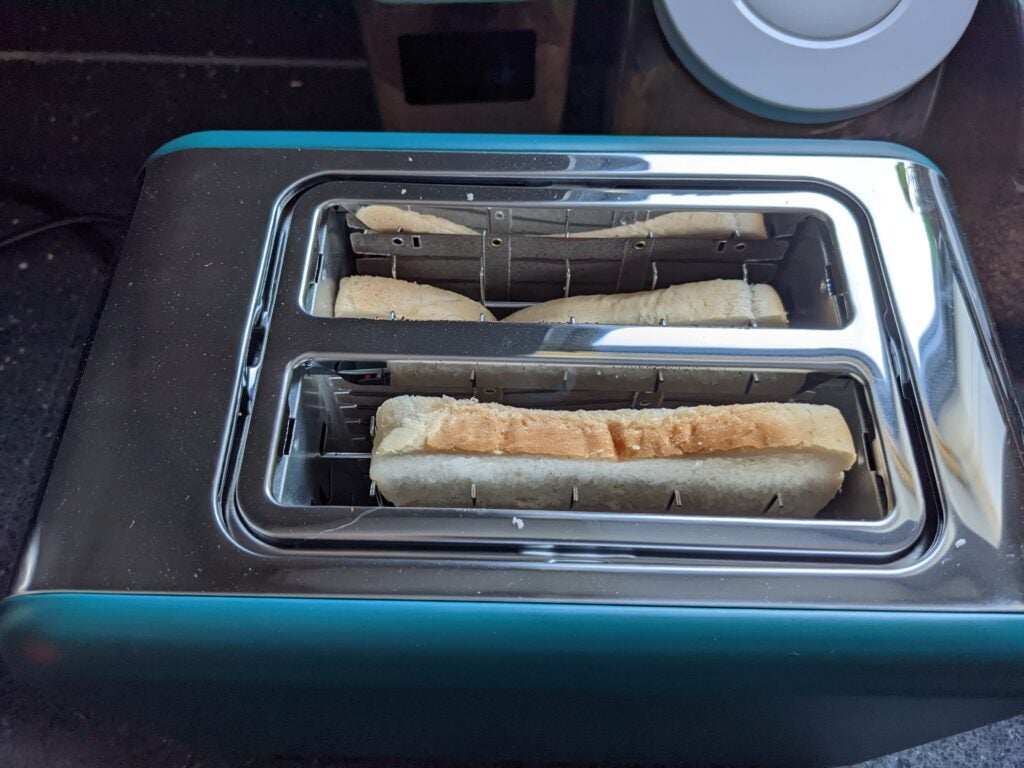
Performance
- Very even toasting
- Low power use
- Highest settings are pointless
Provided you can fit your chosen bread in its slots, the Salter Elder two-slot toaster will brown it evenly. It toasted bagels about as evenly as I’ve managed, and turned frozen sliced white bread the perfect shade. My homemade bread came out extremely evenly toasted – although it was almost too tall for the slots.
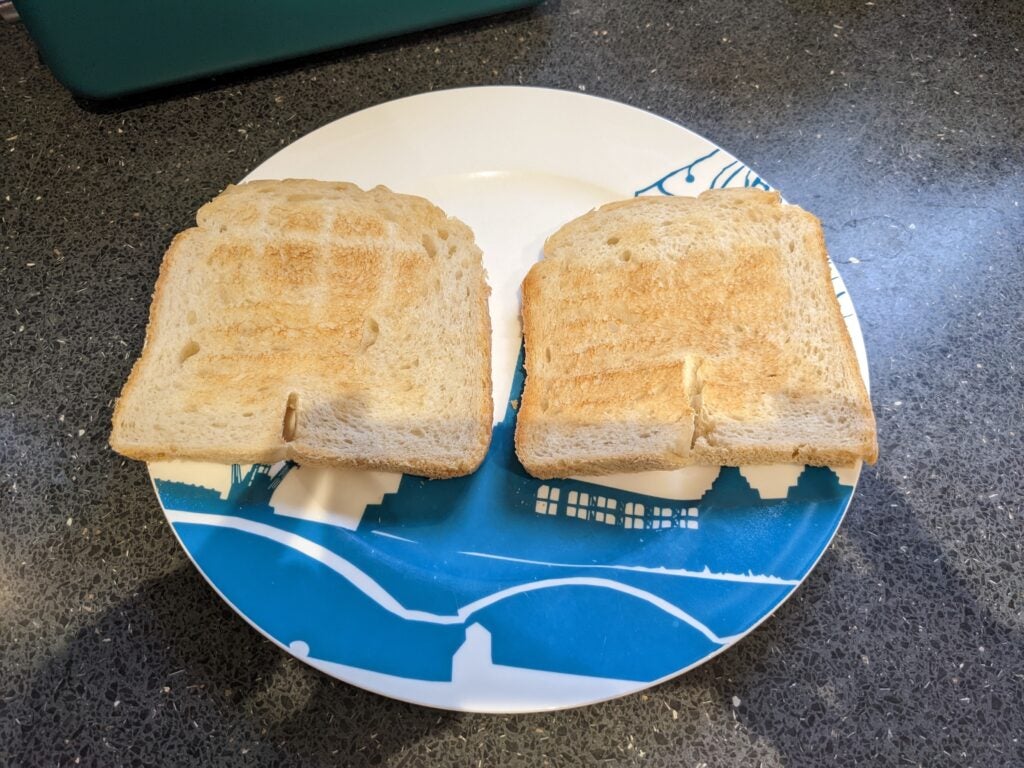
I noticed this toaster was very consistent – the same settings tended to work identically every time, reducing the need for guesswork and reheating. That said, the browning control seems to be calibrated rather oddly. Thick-cut homemade bread was almost burnt at 3.5 out of six, and still slightly overdone for my tastes at 2.5. Given that fresh bread usually toasts more slowly than other bread types, I was left wondering what happens at setting 4 or above, and why anyone would need it.
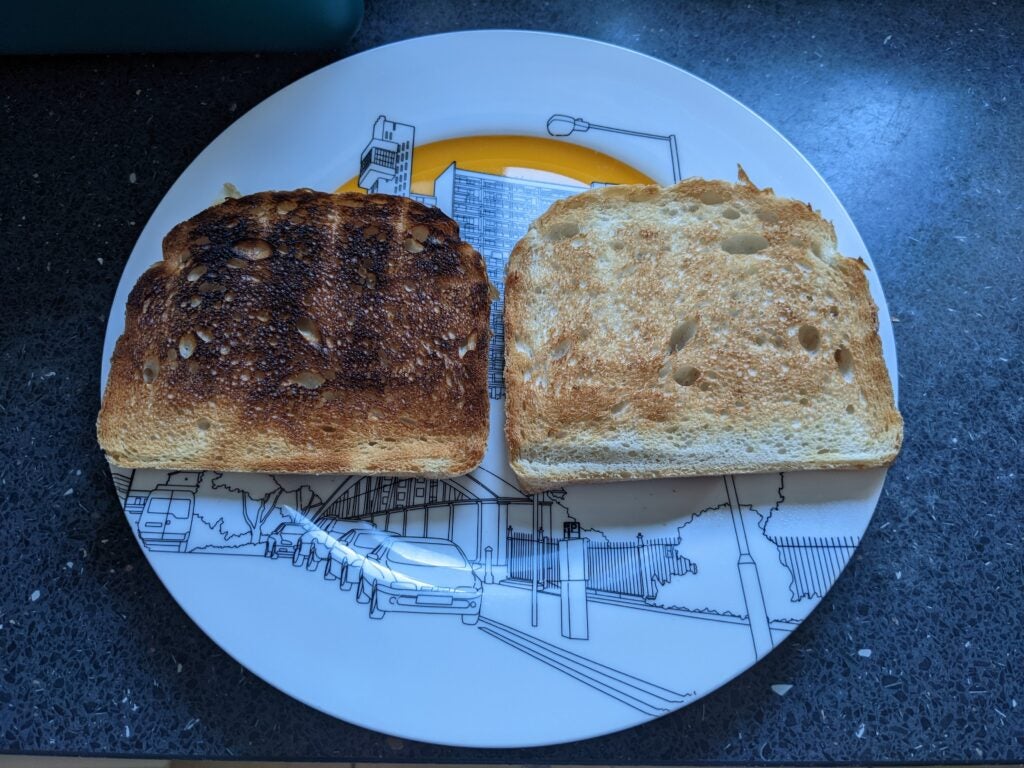
Salter says this toaster is rated at 850 watts, but I measured 950W of consumption. That’s typical for a two-slot toaster, equating to around 0.02 kilowatt hours (kWh) when toasting bagels, and 0.04 kWh for homemade bread. At the current 34p per kWh cap, that’s less than a penny per use – toasters really aren’t that expensive to run.
Latest deals
Should you buy it?
If you want a great looking toaster for a reasonable price, this is a good shout.
Look elsewhere if you want bigger or more slots.
Final Thoughts
For a cheap appliance, the Salter Elder two-slot toaster gets most things right. It looks great, and does a good job on bread and bagels – provided you keep the dial set low. Its reheat and frozen modes are handy, too. It’s a shame, then, that it’s let down by an almost invisible browning control ring, and slots that are only just big enough for everyday sliced bread. Check out alternatives in our guide to the best toasters.
How we test
Unlike other sites, we test every toaster we review thoroughly over an extended period of time. We use standard tests to compare features properly. We’ll always tell you what we find. We never, ever, accept money to review a product.
Find out more about how we test in our ethics policy.
Used as our main toaster for the review period
We test with different sized bread, and see how well the toaster toasts one bit of bread. We follow up with a second slice immediately after to see if the toaster burns the second slice.
We test other cooking features where available: sandwich presses, grilling, etc.
FAQs
I found the control almost impossible to read without glasses, but you could apply a quick fix by painting a black or white line on the ring with a marker or correction fluid.
The Salter Elder Two-Slice Toaster is a good looking two-slot device at a low price. It’s not bad for features, either, but shallow slots and an unreadable browning dial take the shine off. It’s hard to love its fake wood toasting lever, either.
Pros
- Looks great
- Reheat and defrost functions
- Affordable
Cons
- Shallow slots
- Poor browning control
- No single-slice setting
Availability
- UKRRP: £35
- USAunavailable
- Europeunavailable
- Canadaunavailable
- Australiaunavailable
Introduction
This two-slot toaster is part of the Salter Elder range, which is mostly distinguished by muted, modern panel colours and a dash of wood. This is a budget toaster, but it doesn’t look like it – its teal panels look fantastic in a modern kitchen. It’s a shame, then, that its browning control is awful, and its slots are just a bit too small.
Design and features
- Looks great
- Basic features
- Awful browning control
This isn’t quite an entry-level toaster, but it’s still a cheap device. Many toasters at this price are plastic clad and cheap looking, but the Salter Elder two-slice is an exception. Made from metal, with lovely deep teal side panels, it looks much better in the flesh than in photos, complementing my dark grey kitchen countertop nicely.

It’s not all great, though. While Salter’s description suggests you get a touch of wood, the toasting knob is actually plastic. In the flesh, it’s none too convincing: a slightly cheap note on an otherwise good-looking product. On the plus side, this is a small and light toaster – ideal if you hope to tidy it away when not in use. It’s also helpful when you need to empty the crumb tray.

This toaster has two parallel slots, with conventional wire-type elements. It features useful frozen and reheat modes, but there’s no baguette/bagel mode. It’s also missing a single-slot button – if you only fancy a slice, you’ll still be paying to heat both slots. As you’d probably expect, the toast basket isn’t damped, and there’s no bell to alert you when it’s done. Unless you’re in the kitchen, you might miss the relatively muted noise it makes when popping up.
This toaster’s chrome browning control looks great, until you try to use it. There are six toasting levels marked around the outside, but only a tiny dimple on the rotating ring to show you which one you’ve selected. You’ll need keen eyes and decent light to even see this from straight on, and it’s literally invisible from the top of the control. It desperately needs a bold black line across the outside and front of the ring.

In use, another limitation quickly becomes apparent. This toaster’s slots can accommodate a cut bagel, and they just about handled thick-cut homemade bread, but they’re too shallow. Even supermarket sliced bread was slightly too tall for them. I toasted it lying down, and even then the slots were only just long enough to fit it in.

Performance
- Very even toasting
- Low power use
- Highest settings are pointless
Provided you can fit your chosen bread in its slots, the Salter Elder two-slot toaster will brown it evenly. It toasted bagels about as evenly as I’ve managed, and turned frozen sliced white bread the perfect shade. My homemade bread came out extremely evenly toasted – although it was almost too tall for the slots.

I noticed this toaster was very consistent – the same settings tended to work identically every time, reducing the need for guesswork and reheating. That said, the browning control seems to be calibrated rather oddly. Thick-cut homemade bread was almost burnt at 3.5 out of six, and still slightly overdone for my tastes at 2.5. Given that fresh bread usually toasts more slowly than other bread types, I was left wondering what happens at setting 4 or above, and why anyone would need it.

Salter says this toaster is rated at 850 watts, but I measured 950W of consumption. That’s typical for a two-slot toaster, equating to around 0.02 kilowatt hours (kWh) when toasting bagels, and 0.04 kWh for homemade bread. At the current 34p per kWh cap, that’s less than a penny per use – toasters really aren’t that expensive to run.
Latest deals
Should you buy it?
If you want a great looking toaster for a reasonable price, this is a good shout.
Look elsewhere if you want bigger or more slots.
Final Thoughts
For a cheap appliance, the Salter Elder two-slot toaster gets most things right. It looks great, and does a good job on bread and bagels – provided you keep the dial set low. Its reheat and frozen modes are handy, too. It’s a shame, then, that it’s let down by an almost invisible browning control ring, and slots that are only just big enough for everyday sliced bread. Check out alternatives in our guide to the best toasters.
How we test
Unlike other sites, we test every toaster we review thoroughly over an extended period of time. We use standard tests to compare features properly. We’ll always tell you what we find. We never, ever, accept money to review a product.
Find out more about how we test in our ethics policy.
Used as our main toaster for the review period
We test with different sized bread, and see how well the toaster toasts one bit of bread. We follow up with a second slice immediately after to see if the toaster burns the second slice.
We test other cooking features where available: sandwich presses, grilling, etc.
FAQs
I found the control almost impossible to read without glasses, but you could apply a quick fix by painting a black or white line on the ring with a marker or correction fluid.




















